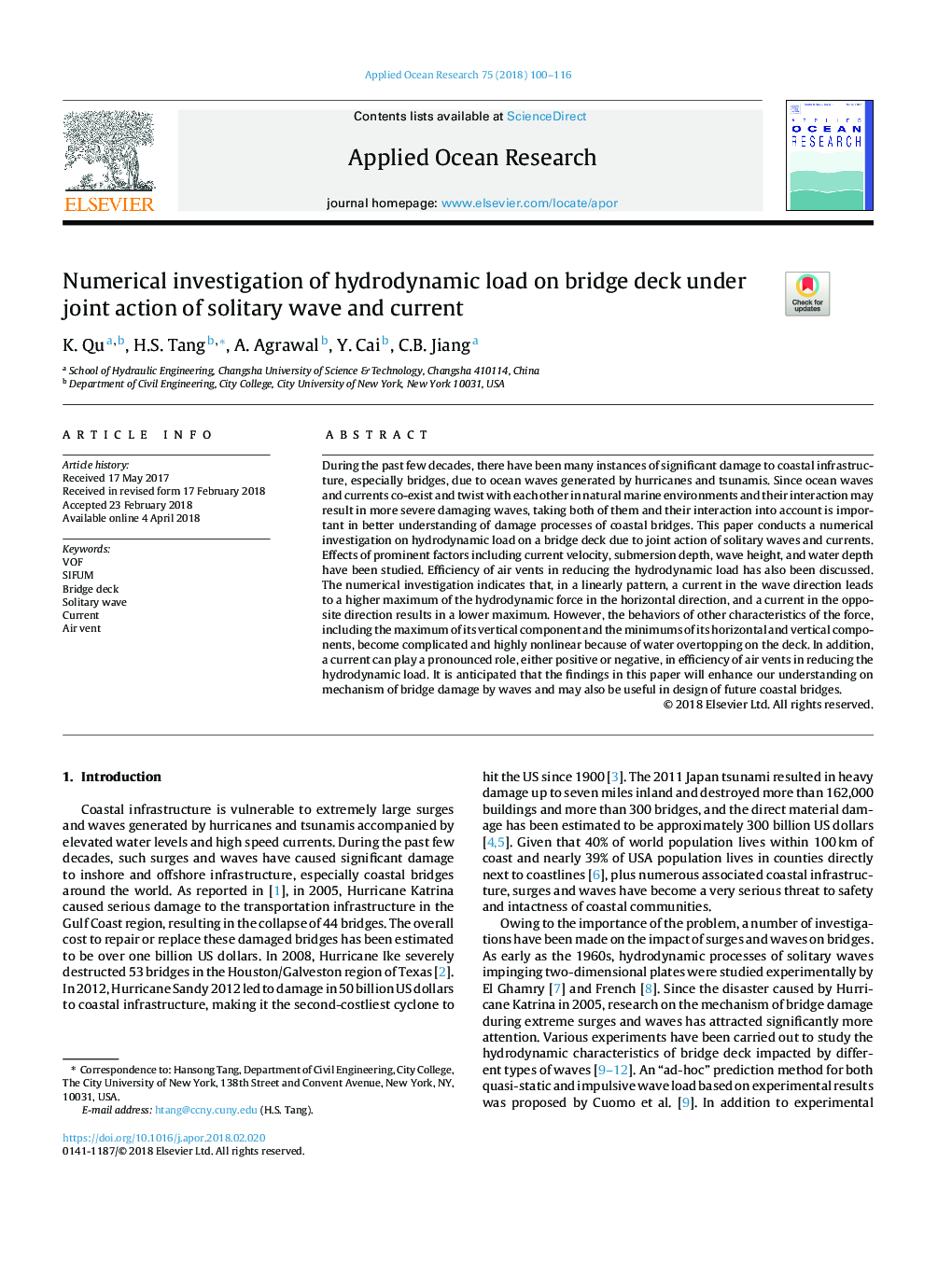| کد مقاله | کد نشریه | سال انتشار | مقاله انگلیسی | نسخه تمام متن |
|---|---|---|---|---|
| 8059263 | 1520228 | 2018 | 17 صفحه PDF | دانلود رایگان |
عنوان انگلیسی مقاله ISI
Numerical investigation of hydrodynamic load on bridge deck under joint action of solitary wave and current
ترجمه فارسی عنوان
بررسی عددی بار هیدرودینامیک بر روی عرشه پل تحت عمل مشترک موج و انحناء جریان
دانلود مقاله + سفارش ترجمه
دانلود مقاله ISI انگلیسی
رایگان برای ایرانیان
ترجمه چکیده
در طی چند دهه گذشته، به علت امواج اقیانوس ایجاد شده توسط طوفان ها و سونامی ها، موارد زیادی از آسیب قابل توجهی به زیرساخت های ساحلی، به ویژه پل ها وارد شده است. از آنجایی که امواج اقیانوس و جریانها در محیط های طبیعی دریایی همدیگر را در هم می آمیزند و همدیگر را در محیط دریایی پیچش می کنند و تعامل آنها می تواند موج های شدیدتری را ایجاد کند، هر دو از آنها استفاده می کنند و تعاملات آنها در درک بهتر فرایندهای آسیب های پل های ساحلی مهم است. این مقاله یک بررسی عددی بر بار هیدرودینامیکی در یک عرشه پل به علت عمل مشترک امواج و انفجارها انجام می دهد. تاثیر عوامل برجسته از جمله سرعت جریان، عمق نفوذ، ارتفاع موج و عمق آب مطالعه شده است. کارایی دریچه های هوا در کاهش بار هیدرودینامیکی نیز مورد بحث قرار گرفته است. تحقیقات عددی نشان می دهد که در یک الگوی خطی جریان در جهت موج منجر به حداکثر حداکثر نیروی هیدرودینامیکی در جهت افقی می شود و جریان در جهت مخالف به حداکثر پایین می رسد. با این حال، رفتار دیگر ویژگی های نیرو، از جمله حداکثر اجزای عمودی آن و حداقل اجزای افقی و عمودی آن، به دلیل بالا رفتن آب در عرشه، پیچیده و بسیار غیر خطی می شود. علاوه بر این، یک جریان می تواند نقش قابل توجهی داشته باشد، مثبت یا منفی، در کارایی دریچه های هوا در کاهش بار هیدرودینامیکی. پیش بینی شده است که یافته های این مقاله درک ما در مورد مکانیزم آسیب های پل توسط امواج را افزایش داده و همچنین ممکن است در طراحی پل های ساحلی آینده مفید باشد.
موضوعات مرتبط
مهندسی و علوم پایه
سایر رشته های مهندسی
مهندسی دریا (اقیانوس)
چکیده انگلیسی
During the past few decades, there have been many instances of significant damage to coastal infrastructure, especially bridges, due to ocean waves generated by hurricanes and tsunamis. Since ocean waves and currents co-exist and twist with each other in natural marine environments and their interaction may result in more severe damaging waves, taking both of them and their interaction into account is important in better understanding of damage processes of coastal bridges. This paper conducts a numerical investigation on hydrodynamic load on a bridge deck due to joint action of solitary waves and currents. Effects of prominent factors including current velocity, submersion depth, wave height, and water depth have been studied. Efficiency of air vents in reducing the hydrodynamic load has also been discussed. The numerical investigation indicates that, in a linearly pattern, a current in the wave direction leads to a higher maximum of the hydrodynamic force in the horizontal direction, and a current in the opposite direction results in a lower maximum. However, the behaviors of other characteristics of the force, including the maximum of its vertical component and the minimums of its horizontal and vertical components, become complicated and highly nonlinear because of water overtopping on the deck. In addition, a current can play a pronounced role, either positive or negative, in efficiency of air vents in reducing the hydrodynamic load. It is anticipated that the findings in this paper will enhance our understanding on mechanism of bridge damage by waves and may also be useful in design of future coastal bridges.
ناشر
Database: Elsevier - ScienceDirect (ساینس دایرکت)
Journal: Applied Ocean Research - Volume 75, June 2018, Pages 100-116
Journal: Applied Ocean Research - Volume 75, June 2018, Pages 100-116
نویسندگان
K. Qu, H.S. Tang, A. Agrawal, Y. Cai, C.B. Jiang,
